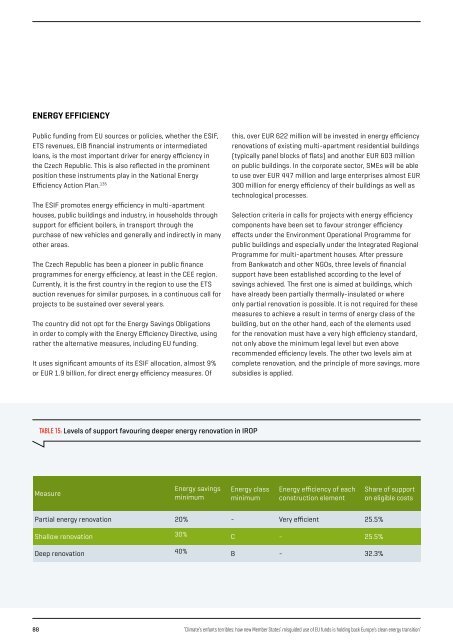ENFANTS TERRIBLES
enfants-terribles
enfants-terribles
You also want an ePaper? Increase the reach of your titles
YUMPU automatically turns print PDFs into web optimized ePapers that Google loves.
ENERGY EFFICIENCY<br />
Public funding from EU sources or policies, whether the ESIF,<br />
ETS revenues, EIB financial instruments or intermediated<br />
loans, is the most important driver for energy efficiency in<br />
the Czech Republic. This is also reflected in the prominent<br />
position these instruments play in the National Energy<br />
Efficiency Action Plan. 135<br />
The ESIF promotes energy efficiency in multi-apartment<br />
houses, public buildings and industry, in households through<br />
support for efficient boilers, in transport through the<br />
purchase of new vehicles and generally and indirectly in many<br />
other areas.<br />
The Czech Republic has been a pioneer in public finance<br />
programmes for energy efficiency, at least in the CEE region.<br />
Currently, it is the first country in the region to use the ETS<br />
auction revenues for similar purposes, in a continuous call for<br />
projects to be sustained over several years.<br />
The country did not opt for the Energy Savings Obligations<br />
in order to comply with the Energy Efficiency Directive, using<br />
rather the alternative measures, including EU funding.<br />
It uses significant amounts of its ESIF allocation, almost 9%<br />
or EUR 1.9 billion, for direct energy efficiency measures. Of<br />
this, over EUR 622 million will be invested in energy efficiency<br />
renovations of existing multi-apartment residential buildings<br />
(typically panel blocks of flats) and another EUR 603 million<br />
on public buildings. In the corporate sector, SMEs will be able<br />
to use over EUR 447 million and large enterprises almost EUR<br />
300 million for energy efficiency of their buildings as well as<br />
technological processes.<br />
Selection criteria in calls for projects with energy efficiency<br />
components have been set to favour stronger efficiency<br />
effects under the Environment Operational Programme for<br />
public buildings and especially under the Integrated Regional<br />
Programme for multi-apartment houses. After pressure<br />
from Bankwatch and other NGOs, three levels of financial<br />
support have been established according to the level of<br />
savings achieved. The first one is aimed at buildings, which<br />
have already been partially thermally-insulated or where<br />
only partial renovation is possible. It is not required for these<br />
measures to achieve a result in terms of energy class of the<br />
building, but on the other hand, each of the elements used<br />
for the renovation must have a very high efficiency standard,<br />
not only above the minimum legal level but even above<br />
recommended efficiency levels. The other two levels aim at<br />
complete renovation, and the principle of more savings, more<br />
subsidies is applied.<br />
TABLE 15: Levels of support favouring deeper energy renovation in IROP<br />
Measure<br />
Energy savings<br />
minimum<br />
Energy class<br />
minimum<br />
Energy efficiency of each<br />
construction element<br />
Share of support<br />
on eligible costs<br />
Partial energy renovation 20% - Very efficient 25.5%<br />
Shallow renovation 30% C - 25.5%<br />
Deep renovation 40% B - 32.3%<br />
135<br />
See: Ministry of Industry and Trade: 3rd National Energy Efficiency Action Plan, 2014.<br />
88<br />
‘Climate’s enfants terribles: how new Member States’ misguided use of EU funds is holding back Europe’s clean energy transition’


